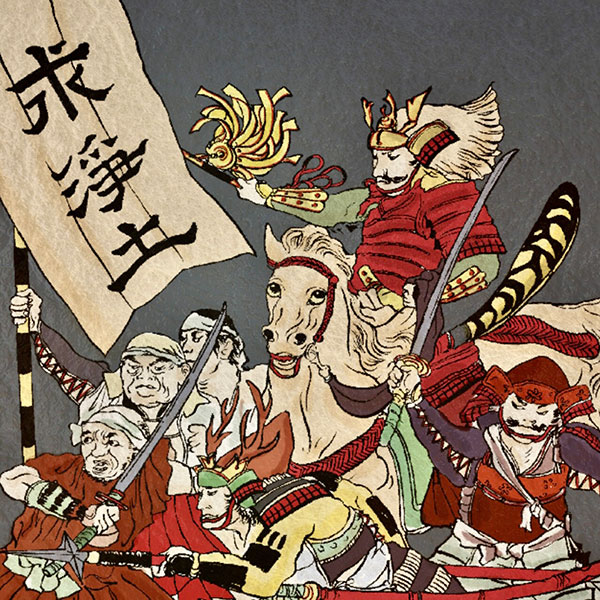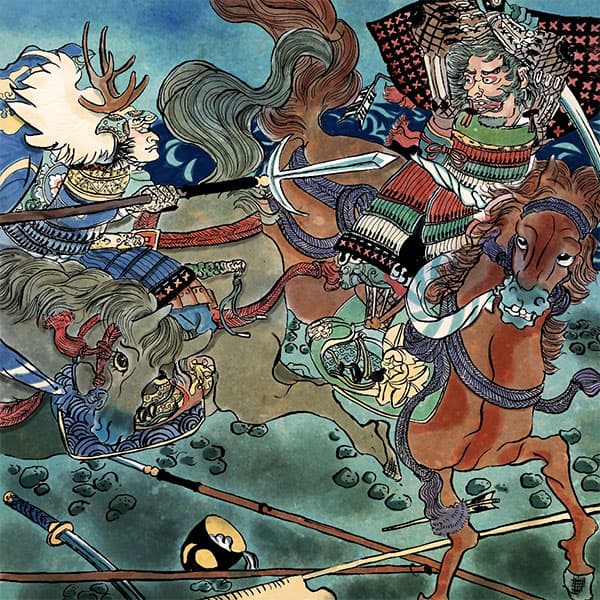Tadatsugu Sakai (1/2)First of the Tokugawa Four Heavenly Kings

Tadatsugu Sakai
- Article category
- biography
- name
- Tadatsugu Sakai (1527-1596)
- place of birth
- Aichi prefecture
- Related castles, temples and shrines

Okazaki Castle

Yoshida Castle

Nagashino Castle
- related incident
It was Tokugawa Ieyasu who survived the Warring States era and took over the country by defeating Ishida Mitsunari at the Battle of Sekigahara. Tokugawa Ieyasu had many hardships as a child, and even in his youth he formed an alliance with Oda Nobunaga, making it difficult for him to become a leading figure. Tokugawa Ieyasu, who was supported by such Mikawa samurai, had vassals known as the Tokugawa Four Heavenly Kings who were particularly distinguished by their merits, the chief among them being Tadatsugu Sakai. This time, I would like to take a look at the life of Tadatsugu Sakai.
Birth and youth of Tadatsugu Sakai
He was born in 1527 at Ida Castle, Nukata District, Mikawa (near Shiroyama Park, Ida Town, Okazaki City, Aichi Prefecture) as the second son of Tadachika Sakai, a fudai vassal of the Matsudaira clan, the predecessor of the Tokugawa clan. After coming of age, he served Hirotada Matsudaira, father of Tokugawa Ieyasu, and took the name Kogoro Sakai, later Saemon nojo.
When Takechiyo (Tokugawa Ieyasu) was to go to Sunpu as a hostage for Yoshimoto Imagawa, he was the second oldest vassal following Masachika Sakai (23 years old at the time) to accompany Takechiyo.
After this, he served as a subordinate of Motonobu Matsudaira (Tokugawa Ieyasu) and lived in Fukutani Castle from the early Koji era. In 1556, when Fukutani Castle was attacked by Katsuie Shibata with 2,000 horsemen, Tadatsugu went outside the castle and fought, and after a fierce battle, defeated Katsuie, showing great military prowess even back then. . Regarding the attack and defense of Fukuya Castle, there are many stories about Tokugawa Ieyasu's glorious military exploits during his subjugation period, such as ``Tosho Gunkan'', ``Butoku Taiseiki'', ``Ietada Diary'', ``Okubo Tadakatsufu'', ``Abe Tadamasafu'', ``Gonenfu'', and ``Tokugawa Miki''. It is said that it was even included in many of the records kept by the Tokugawa family.
After the Battle of Okehazama in May 1560, he became the chief retainer of the Tokugawa family, and during the Mikawa Ikko Ikki in 1563, many members of the Sakai clan, including Tadayao Sakai, sided with the Ikko Ikki. On the other hand, only Tadatsugu followed Ieyasu.
In 1564, he served as the vanguard in the attack on Yoshida Castle, forcing the defender, Shizumi Obara, to retreat and achieving a bloodless surrender of the castle. As a reward, he was made the lord of Yoshida Castle after the war.
As a result, Tadatsugu was given the role of controlling the Moromatsudaira family and kokunin in the eastern part of Mikawa as the leader of eastern Mikawa (Ienari Ishikawa in western Mikawa).
At the end of 1569, Takeda Shingen of Kai Province invaded Imagawa Ujizane's territory of Suruga (Suruga Invasion), but the Tokugawa clan initially allied with the Takeda clan and made an agreement to cede the Imagawa territory. I was there. Tadatsugu plays an important role, including being in charge of negotiations with the Takeda side.
From early adulthood to later years
At the Battle of Anegawa in 1570, he took up positions along the Anegawa River and, together with Nobuoki Ogasawara's troops, rushed into the Asakura army and played the role of opening fire. In addition, in the Battle of Mikatagahara in 1573, one of Tokugawa Ieyasu's most critical moments in his life, he was on the right wing, colliding with and defeating the enemy's Nobushige Oyamada army.
Later, at the Battle of Nagashino in 1575, he led a detachment in an assault from Tobisuyama Fort, which was located behind Takeda Katsuyori. In addition to capturing Tobisuyama Fort and rescuing Nagashino Castle, he also achieved great military exploits by defeating Katsuyori's uncle Nobuzane Kawakubo and others, as well as the Takeda branch of Ariumi Village.
Tadatsugu had deep trust from Ieyasu. In 1579, when he was questioned by Nobunaga Oda regarding Ieyasu's eldest son, Nobuyasu Matsudaira, he was sent to Azuchi Castle along with Tadayo Okubo to make excuses.
At this time, it is said that Tadatsugu was unable to adequately defend Nobuyasu and prevent Nobuyasu from committing seppuku. However, there are still many unnatural and questionable points regarding this popular theory of Nobuyasu seppuku, including the Azuchi Nikki (the most ancient and most reliable of the Nobunaga Koki) and the contemporary In recent years, the theory that Nobuyasu's seppuku was Ieyasu's intention has become popular, as stated in the ``Ki''.
As proof of this, he continued to serve Ieyasu as a senior vassal.
After the Honnoji Incident that occurred on June 2, 1582, Ieyasu attempted to take control of Kai and Shinano, the Takeda territories that had become vacant after Nobunaga was defeated (Tensho Migo War). ). On June 27 of the same year, Tadatsugu was dispatched to Shinano to try to appease the people of Shinano. Tadatsugu invaded Shinano via Okumikawa and Ina, but failed due to the defection of Suwa Yoritada and Ogasawara Sadayoshi.
He also participated in all of Ieyasu's major battles, including defeating Mori Nagayoshi at the Battle of Haguro in the Battle of Komaki and Nagakute in 1584.
After Kazumasa Ishikawa, who was also Ieyasu's innkeeper, ran away in 1585, he was treated as Ieyasu's most important vassal, and on October 24, 1586, he was promoted to Jushi, the highest ranking member of the family. He was appointed to the rank of Saemon no kō.
In October 1588, he handed over the headship of his eldest son, Ietsugu, and retired. Although aging was a factor in his retirement, it is also said that he suffered from an eye disease and could hardly see.
He lived in Kyoto, and Toyotomi Hideyoshi gave him a mansion in Sakurai, Kyoto, a woman to take care of him, and 1,000 koku for his stay in Kyoto, and there is an anecdote that around this time, he entered Buddhism and took the name ``Ichichi.'' He died on October 28, 1596, at the Sakurai residence in Kyoto. Passed away at the age of 70. His grave is located in the sub-temple of Chion-in Temple, Sengu-in Temple, and his grave is in the cemetery on the side of the mountain of Chion-in Temple.
Genealogy of the Sakai family
The Sakai clan is said to be a brother of Oyaji, the founder of the Matsudaira clan. (There is also a theory that they are brothers by marriage)
In addition, he is not only the oldest shuro in the Matsudaira family, known as the Ansho Fudai, but Tadatsugu also has deep blood ties to the Matsudaira clan. Tadatsugu's legal wife was Princess Usui, the daughter of Ieyasu's grandfather, Kiyoyasu Matsudaira, and his wife, Otomi. Otomi was the legal wife of Tadamasa Mizuno before becoming Kiyoyasu's legal wife, and was also the biological mother of Ieyasu's mother, Odai. Therefore, Tadatsugu is Ieyasu's husband and uncle-in-law to Ieyasu's younger sister. Children such as Ietsugu and Yasutoshi Honda were born to Princess Usui, and Ietsugu, who inherited the headship of the family, went from 30,000 koku in the Shimousa-Usui domain to 100,000 koku in the Echigo-Takada domain, and his descendants ended up in the Dewa-Shonai domain for 17 years. He became one of the most important players in the history of Mangoku and Fudai.
In addition to this, a branch of the clan established three clans in Dewa. Furthermore, the lineage of Yasutoshi, who inherited the Ina Honda clan, continued until the end of the Edo period, so it can be said that the descendants of the family prospered greatly.
Tadatsugu's favorite weapon
Tadatsugu Sakai was 15 years older than Tokugawa Ieyasu. He was the oldest of the four so-called Tokugawa Four Heavenly Kings (in addition to Tadatsugu, Tadakatsu Honda, Yasumasa Sakakibara, and Naomasa Ii), but he often took the lead in battles and attacked the enemy with his favorite spear. He had the courage to go for it.
- related incident

- WriterTomoyo Hazuki(Writer)I have loved history and geography since my student days, and have enjoyed visiting historical sites, temples and shrines, and researching ancient documents. He is especially strong in medieval Japanese history and European history in world history, and has read a wide range of things, including primary sources and historical entertainment novels. There are so many favorite military commanders and castles that I can't name them, but I especially like Hisashi Matsunaga and Mitsuhide Akechi, and when it comes to castles, I like Hikone Castle and Fushimi Castle. Once you start talking about the lives of warlords and the history of castles, there's a side of you that can't stop talking about them.












